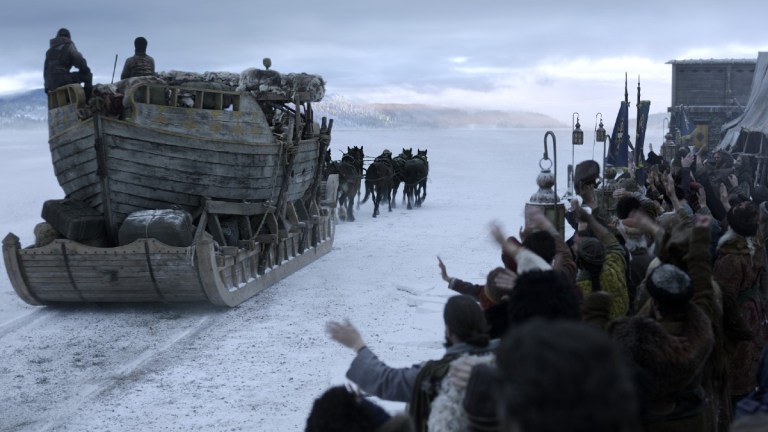Why Vikings: Valhalla Season 2 Is Actually a Road Trip Show
Creator Jeb Stuart talks about taking Vikings: Valhalla out of its comfort zone (literally) in season 2.

This article contains spoilers for Vikings: Valhalla season 2.
One of the most interesting aspects of Vikings: Valhalla season 2 is the way the series literally opens up the world to its story and characters. Yes, there’s still plenty of scheming, bloodshed, and betrayal, but gone is the sense that this is an insular story taking place among a small sub-group of people. In season 2, Valhalla sees its trio of main characters head off on separate adventures that literally span continents as the show does its best to depict the immense influence that Viking culture had on much of the known world—both during the 11th century and for hundreds of years afterward.
The original Vikings series was predominantly centered around Kattegat, and while there were certainly several notable forays into other locations over the course of its six seasons, all roads eventually led back to the Norwegian town and the struggles of various parties to control its future. Season 2 of Valhalla does its best to expand the world of the show, introducing new characters, new countries, and new destinies along the way.
The original Vikings series was predominantly centered around Kattegat, and while there were certainly several notable forays into other locations over the course of its seven seasons, all roads eventually led back to the Norwegian town and the struggles of various parties to control its future. Season 2 of Valhalla does its best to expand the world of the show, introducing new characters, new countries, and new destinies along the way.
“I think season 2 is a road show,” Valhalla creator Jeb Stuart tells Den of Geek. “What does it mean when you take these Viking ideals and this Viking spirit on the road? Does it hold up in the Rus as well as it holds up in Scandinavia?”
Often when modern-day viewers think about the Vikings, we tend to remember them as a people who continually journeyed westward, toward England, Greenland, and even North America, but they actually explored much of the known world, traveling as far south as northern Africa, east as far as Russian and through the Mediterranian as far as Constantinople and the Middle East. What were those explorations like? How did Vikings interact with and influence these other cultures? In what ways were they influenced themselves?
These are just a few of the questions that Valhalla does its best to poke at as its second season, which not only introduces an entirely new Viking world within the hidden stronghold of Jomsborg, it sends Harald and Lief off on a journey through some of the medieval world’s most famous locations. The duo turns eastward, setting out for the city of Novgorod in the Kievan Rus, on a mission to get King Yaroslav to back one nephew’s (Harald) claim to the throne of Norway over the other’s (Olaf). Along the way, they discover everything from opium dens to slave traders, fighting rings, and roving bands of Pecheneg tribal warriors.
“Historically, we know that Harald was expelled from Scandinavia at that time so we had to get him on the road,” Stuart says. “I love Harald’s character, he was this pampered Prince of Norway and now he has nothing. He had everything at his fingertips and suddenly he becomes a fugitive and now he gets to go out and see if that Viking culture holds up in the greater world. That, for me, is a really fun arc and [Leo Suter] carries it beautifully.”
The episodes in which Leif and Harald are among the Rus are some of the season’s most visually and thematically interesting, as we see the pair apply Viking ingenuity to various seemingly unsolvable problems—building a boat that is subsequently carried down a frozen river on a massive sled, sailing said boat over a waterfall on purpose to further their journey south—and build meaningful relationships with an assortment of diverse characters from other cultures.
“Season two becomes much more introspective,” Stuart says. “You’re really out there on your own, you have to hold on to certain pieces of who you are on your own. And the Harald, the Freydis, the Leif parts of that, it becomes really tough [for them] to do. And now there’s this kind of Dickens-like novel of all these incredible, wonderful characters that they come into contact with—well, that’s life. As you expand out of your home base, you’re suddenly confronted by so many different cultures and thoughts and ideas that you never would’ve realized if you’d stayed in Kattegat.”
From a determined daughter of a nobleman of Kievan Rus to the disgraced brother of a Penecheng khan, almost everyone Lief and Harald meet offers them new perspectives or teaches them something they never would have learned otherwise, particularly Mariam, to a Muslim female scholar and astronomer from Constantinople, who helps Leif understand the world in a whole new way.
“I thought it was really fun to be able to bring in a woman from the House of Wisdom, which is one of those fascinating places,” Stuart says. “One of the incredible things about the 11th century is that women in that culture, coming out of Baghdad, had the ability to be these scholars. And like so many things, those doors open and close, and at that time the door was open, so it was wonderful to get the chance to write a character like that”
For Stuart, it makes perfect sense that a Viking like Lief would be drawn to a scholar like Mariam, who understands so much about everything from the movements of the stars and how they can be used in navigation to mathematics and languages. Her life of travel and exploration speaks to him, as does her obvious love of knowledge, but the show doesn’t treat the mere fact of her existence as particularly extraordinary. And that’s on purpose.
“Look at Emma of Normandy, she’s one of the richest women in Europe, and she’s one of the rulers of England. After 1066 and William came, the door closed for women’s rights for a thousand years,” he says. “So for a character like Mariam, for a Muslim character, a female role like that, at that time, to be in the scholarly world, it’s just fantastic. I loved working with [those characters] and the Viking culture, it just resonates, it allows these things to happen.”
For all that Vikings can sometimes be portrayed as brutes in our pop culture memories, Valhalla lets the best aspects of their adventurous spirits shine through. At one point, Harald’s uncle Yaroslav softens the blow of his refusal to fund his nephew’s army by telling him that what he’s really doing is offering him an opportunity to do what Vikings do best—reinvent themselves. This is, in its way, what Valhalla itself does in its second season, showing us different sides of the Viking story even as it stays true to the series’ characters and larger themes.
“It was hell balancing all of that,” Stuart says. “And in order to do that I think we had to take some really big, huge leaps. We had so many great moments in season one, and we had to find those same kinds of moments on the road, and I think we’ve done it.”
All eight episodes of Vikings: Valhalla season 2 are available to stream on Netflix now.
